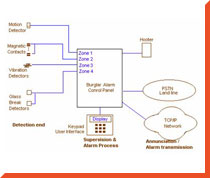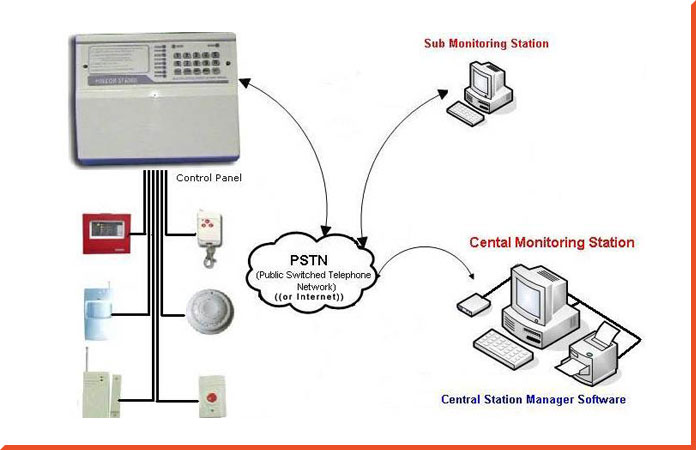Burglar/Intruder Alarm Systems
24 hour electronic sentinels that tirelessly and relentlessly protect the premises from intrusion. These systems use a wide range of sensors including Magnetic Contacts, Passive Infra-Red Motion detectors, Glass-break and Vibration sensors to detect forced entry or unauthorized movement. Alternately, Panic Alarm switches can be used to manually trigger an alarm under threat or duress.
ON a typical Alarm condition, the system sounds the Hooters/Sirens and Flashing Strobe lights which provides local signaling of alarm condition and if required, remote communication of the state of alarm via automatic dialers.
The central control panel that supervises these detectors, differs from the Fire Alarm Control Panel, in that this is an active system. i.e. The Control Panel can be 'Armed' to detect intrusion, when thepremises is supposed to be empty, and Disarmed' when the premises is normally occupied.
The Arming/Disarming can be carried out by means of a key switch, or by a valid code entered through the keypad connected to the unit, or remotely, through a telephone line or automatically through a pre-programmed time & calendar-controlled system. Sophisticated alarm panels, give a date and time stamped, history of all events occurring within the system, that can be viewed through a alphanumeric LCD display, or printed through a separate printer.
Motion Detectors:
To detect an intruder who's already within the secured premises, a motion detector comes in handy.
Radar-based motion detector:
This detector sends out bursts of microwave radio energy and then waits for the reflected energy to bounce back. If there is nobody in front of the detector the radio energy will bounce back in the same pattern. But if somebody entersthe area, the reflection pattern is disturbed. When this happens, the sensor sends a signal and the sensor sends an alarm signal when the reflection pattern in a room is disturbed.
Light energy based detectors:
More advanced security systems include passive infrared (PIR) motion detectors. These sensors "see" the infrared energy emitted by an intruder's body heat. When an intruder walks into the field of view of the detector, the sensor detects a sharp increase in infrared energy. PIR detectors are designed to trigger the alarm only when infrared energy levels change very rapidly.
Dual Technology Motion Detectors:
In order to reduce the event of false alarms, a combination of PIR & Microwave technology is used within one motion detector. Verification across both sensors is carried out in the event of intrusion, before an alarm signal is transmitted.
All these motion detector designs can be combined to offer complete coverage within premises that needs to be guarded. In a typical security system, the central control Panel which is 'armed' will sound the alarm immediately when the motion detectors are triggered.
Burglar Alarm Systems
Burglar alarm systems are normally 12V DC based systems
a) Conventional devices are cost effective, and are normally used when the number of detectors involved is less. The premises that needs to be secured, is divided into separate zones, (Usually 4,8,16,32 zones, etc.,) depending on the capacity of the Control Panel. A single detector or several detectors in a serial loop are connected to each of these physical zones.
In Microprocessor based panels, it is also possible to label each zone depending on the area it is supervising. In case of an intrusion, the panel indicates the precise area, where the intrusion occurred, with the precise time and date stamp.
b) Addressable Systems are more complex systems, where each detector is provided with a unique digital address. Hence many detectors connected parallely, in a single loop, can still be identified individually. Typically, a loop can accommodate around 99 to 127 detectors. This system also simplifies cabling to a great extent.
Any sensor, detecting intrusion, will send an alarm signal, preceded by its relevant digital address to the control panel. A label providing the location of the detector can be programmed corresponding to each address. In case of an intrusion, the panel indicates the precise point, where the intrusion occurred, with the precise time and date stamp. Several keypads with different unique addresses, can be connected.


c) Wireless devices communicate with each other through means of radio waves, usually in the frequency range of 900MHz. All detectors are provided with batteries, and a wireless transmitting device, in addition to its basic sensor circuit. The main control Panel, includes a wireless receiver unit, and is separated to separated into different channels to receive signals from each detector separately. When armed, the Control Panel activates the Siren upon receiving an alarm signal from any one of the detectors. These systems are normally used, when cabling needs to be avoided. However regular checks and replacement of batteries on all detectors needs to be carried out, at least once a year. Only the Main Control Panel, and in some cases the Sounders rely on an external power supply.
d) Hybrid Systems are integrated with Wireless as well as hardwired zones, and is capable of supervising wired as well as wireless detectors and sensors.





















